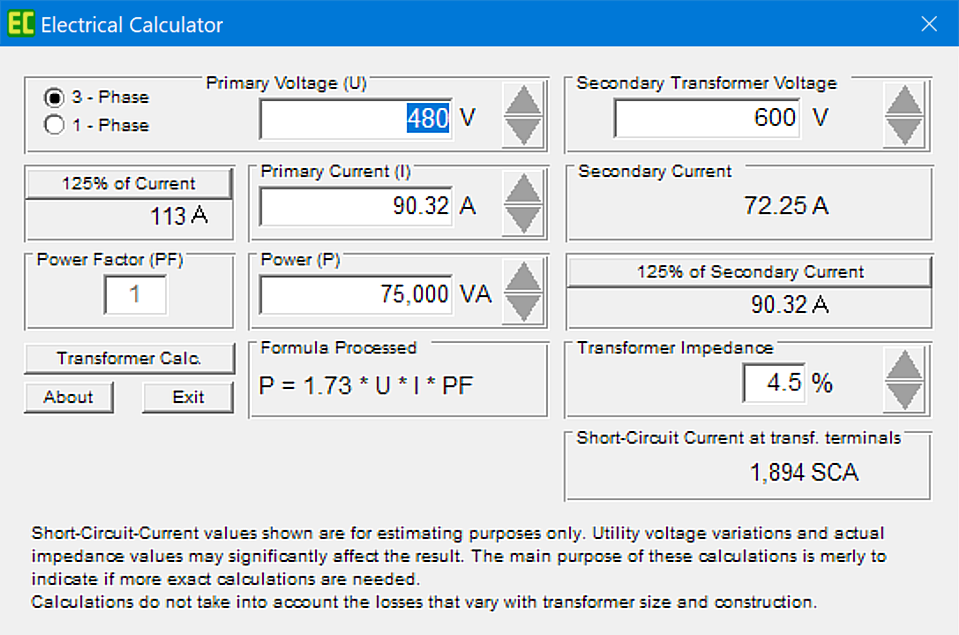

#Electrical engineering calculator simulator
LANGUAGEĭesign and experiment simulator with circuits, both analog and digital. While simulation is running, adjust circuit parameters with analog knob, and the circuit responds to your actions in real time. This gives you insight into circuit operation like no equation does. Build any circuit, tap play button, and watch dynamic voltage, current, and charge animations. LANGUAGEĪvailable in English, Français, Español, Italiano, Deutsch, Português & Nederlands PRICEĪll joking aside, this time you will understand how electronic circuits work. Automatic calculation of results with changes in input values and units. Also calculates Voltage Drop Percentage, Wire Resistance and End Voltage. Voltage Drop Calculator allows you to quickly calculate Voltage Drop in most simple and easiest way for a selected conductor size and type. LANGUAGEĭetermines the appropriate voltage drop for each cable selection.

Consists of 52 Calculators with Formulas and Circuits. LANGUAGEĮnglish, Dutch, French, German, Italian, Portuguese, Simplified Chinese, Spanish PRICEĬalculator – Ohm’s law, with voltage, current, resistance, and power calculations.

LANGUAGEĮlectrotecnia-Pack is a package with 39 electric calculators and 16 electric converters. Energy Cost Calculator: calculates the Operating cost & Energy Usage of Electric Equipments or Machinery. LANGUAGEĬalculate the costs of electrical equipment or machinery by days, weeks, months or year. Includes tests on loads, circuits, safety, symbols, generators, and transformers, among others.
#Electrical engineering calculator free
PRICEĭownload this app FREE by clicking HERE (IOS)ĭesigned by the British Electrical Safety Council, this “app” aims to reduce the risks of electrical accidents at work and at home. LANGUAGEĪvailable in English, French, Spanish, Dutch, Danish, German, Portuguese and Catalan, it is a useful tool for engineers, installers, dealers, students. The App is considering the maximum voltage drop, using UNE 23 Norm as a reference for current ratings. Topmatic helps you select the convenient cross section for your installations. LANGUAGEĭownload this app FREE by clicking HERE (IOS)ĭownload this app FREE by clicking HERE (Android)Ĭalculate the most suitable electric cable section, using the standard UNE 23 as a reference. It’s a must for every electrical engineer. You can find from wire size recommendations to reactive calculations or power conversion features. The views expressed are those of the author(s) and are not necessarily those of Scientific American.The most complete electrical cable calculations app, simple and easy to use.

Photo: USPTO Publication US1552113 A (published September 1, 1925) In 2015, Clarke was elected into the National Inventors Hall of Fame for her Clarke Calculator. The tool also supported Clarke’s work to gather data about the power grid and "can be seen as the first step toward “smart grid” technology according to the U.S. This calculator allowed engineering and analysts to more easily solve these equations and, in turn, more accurately characterize long transmission lines. In response to this challenge, Clarke invented a graphical calculator for solving line equations involving hyperbolic functions. According to Clarke, these assumptions were “not justifiable when the transmission line which is being investigated becomes comparatively long, say a few hundred miles” and led to significant errors in the calculations.Īccording to Clarke, “if accuracy is desired in calculations for long lines, it is absolutely necessary to take into consideration the uniformly distributed inductance and capacity in the line.” But, these calculations were complex and required significant man hours in the days before computers. When Clarke filed her patent application in 1921, engineers and analysts would assume that the capacity and inductance of short transmission lines were concentrated at isolated points along a power line (as opposed to being distributed uniformly along the line). 1957) was a pioneer in electrical engineering, perhaps best known for developing mathematical methods that simplified how engineers characterized long power lines.Ĭlarke’s invention – the “ Clarke Calculator” - greatly simplified calculations used to understand long transmission lines in the days before computers, allowing analysts to solve key equations ten times faster than previous methods.


 0 kommentar(er)
0 kommentar(er)
